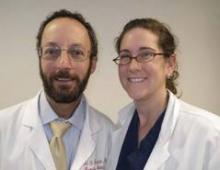Approximately 4,000 women in the United States die every year of cervical cancer. Fifty percent of women with cervical cancer have never been screened, and another 10% were not screened within the previous 5 years. Papanicolaou (Pap) testing has markedly reduced mortality from cervical cancer, helping lower it from first to 14th on the list of causes of cancer deaths in women.
New guidelines from the American Cancer Society, the American Society for Colposcopy and Cervical Pathology, and the American Society for Clinical Pathology address age-appropriate screening strategies, use of cytology and high-risk human papillomavirus (HPV) testing, follow-up, age to cease screening, and the approach to the HPV-vaccinated patient.
Nearly 100% of cervical cancers are caused by HPV. "High-risk HPV" is a term used to identify approximately 15 carcinogenic HPV genotypes, including HPV 16 and HPV 18. Most HPV infections are cleared by the body within 2 years; those that remain have a higher risk of developing precancerous lesions.
Cervical intraepithelial neoplasia (CIN) are precancerous lesions found on the cervix and are classified as CIN 1, 2, or 3, depending on degree of abnormality in the epithelium. CIN 1-2 have a 10%-15% likelihood of progressing to CIN 3 and a 1%-5% risk of becoming cancer. The Bethesda system uses the nomenclature low-grade and high-grade squamous intraepithelial lesion (LSIL and HSIL), which correspond to CIN 1 and CIN 2-3, respectively.
Screening Recommendations
• Initiation of screening: Screening in adolescents and young women has led to unnecessary evaluation and overtreatment of preinvasive cervical lesions that have a high probability of regressing spontaneously.
Recommendation: Cervical cancer screening should begin at age 21 years regardless of age of sexual initiation or other risk factors.
• Periodic screening: Evidence has shown that annual screening leads to a small increase in cancers prevented, at the cost of a large excess of procedures and treatments. Most HPV infections are benign and transient, and lesions will usually regress within 2 years. At worst, these lesions are usually years from causing cancer.
Recommendation: Screening should be periodic, based on age and clinical history, regardless of previous HPV vaccination.
• Screening, 21-29 years: There is a high prevalence of HPV in this age group – mostly benign cases that will regress spontaneously. Studies show no significant difference in cancer reduction between a 2-year and 3-year screening interval. However, there is a tripling in the number of colposcopy referrals in this age group when screening occurs every 2 years.
Recommendation: Women should be screened with cytology alone every 3 years. HPV testing should not be used to screen women in this age group.
• Screening, 30-65 years: There are two types of testing that are appropriate in this age group; one is recommended over the other if available. "Co-testing" refers to the combination of cytology and HPV testing, which increases the ability to detect CIN 3 and allows for a decrease in the interval of screening because of the low risk associated with a negative screen. Co-testing also increases the ability to detect adenocarcinoma. Cytology alone is also acceptable, but there is insufficient evidence to support a longer screening interval, even with previous successive negative screens.
Recommendation: In this age range, co-test screening should be performed every 5 years, or cytology alone every 3 years.
• Screening, older than 65 years: Women who have had CIN 2+ in the past 20 years have a 5- to 10-fold greater risk of developing cervical cancer than does the general population.
Recommendation: Discontinue screening in women older than 65 years who have had no diagnosis of CIN 2+ in the previous 20 years, regardless of sexual activity. For a woman who has been diagnosed or treated for CIN 2+ or adenocarcinoma in situ, routine screening should continue for 20 years, even past age 65 years.
• Screening, women after hysterectomy: Women who have had hysterectomy with removal of the cervix who have no history of CIN 2+ should not be screened.
Management of Abnormal Results
• HPV positive, cytology negative: It is not recommended to send these women immediately for colposcopy. Instead, there are two options: Either repeat co-testing in 12 months, or perform genotype-specific HPV testing for HPV 16 alone or HPV 16/18.
If co-testing is repeated in 12 months, women testing positive on either test (HPV positive or LSIL [low-grade squamous intraepithelial lesion] or greater) should be referred for colposcopy. If genotype testing is performed, then women testing positive for HPV 16 or HPV 16/18 also should be referred for colposcopy. If genotype is negative for HPV 16 or HPV 16/18, then repeat co-testing in 12 months. This is the only situation in which genotype-specific HPV testing is recommended.


